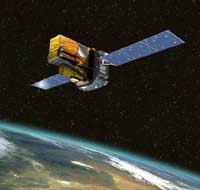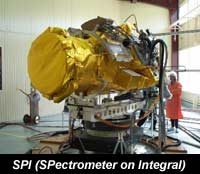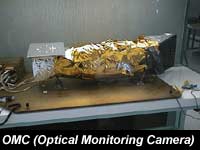INTEGRAL:
The INTErnational Gamma-Ray Astrophysics Laboratory. A project of the European
Space Agency
About INTEGRAL

The ESA scientific mission
INTEGRAL (The INTErnational Gamma-Ray Astrophysics Laboratory)
was selected by
ESA
in 1993 as the next ESA medium-size scientific mission (M2) of the Horizon
2000 program. Launched in October of 2002, the mission was conceived
as an observatory led by ESA with contributions from Russia (PROTON launcher)
and NASA (Deep Space Network ground station).
INTEGRAL is dedicated to the fine spectroscopy (E/E = 500) and fine imaging (angular
resolution: 12 arcmin FWHM) of celestial gamma-ray sources in the energy
range 15 keV to 10 MeV with concurrent source monitoring in the X-ray
(3-35 keV) and optical (V-band, 550 nm) energy ranges. The four experiment
packages are described below.
 The
spectrometer (SPI) (SPectrometer on INTEGRAL) will perform spectral
analysis of gamma-ray point sources and extended regions in the 20 keV - 8
MeV energy range with an energy resolution of 2 keV (FWHM) at 1 MeV. This
will be accomplished using an array of 19 hexagonal high purity Germanium
detectors cooled by a Stirling cooler system to an operating temperature
of 85 K. A hexagonal coded aperture mask is located 1.7 m above the
detection plane in order to image large regions of the sky (fully coded
field of view = 16 degrees) with an angular resolution of 2 degrees. In
order to reduce background radiation, the detector assembly is shielded by
a veto (anticoincidence) system which extends around the bottom and side
of the detector almost completely up to the coded mask. The aperture (and
hence contribution by cosmic diffuse radiation) is limited to ~ 30 degr. A
plastic veto is provided below the mask to further reduce the 511 keV
background. The GSFC Astrophysics Science Divison scientists Drs. Steve
Sturner and Chris Shrader are
responsible for generating and testing updated SPI instrument response
functions which are required when any of the 19 detectors fail.
The
spectrometer (SPI) (SPectrometer on INTEGRAL) will perform spectral
analysis of gamma-ray point sources and extended regions in the 20 keV - 8
MeV energy range with an energy resolution of 2 keV (FWHM) at 1 MeV. This
will be accomplished using an array of 19 hexagonal high purity Germanium
detectors cooled by a Stirling cooler system to an operating temperature
of 85 K. A hexagonal coded aperture mask is located 1.7 m above the
detection plane in order to image large regions of the sky (fully coded
field of view = 16 degrees) with an angular resolution of 2 degrees. In
order to reduce background radiation, the detector assembly is shielded by
a veto (anticoincidence) system which extends around the bottom and side
of the detector almost completely up to the coded mask. The aperture (and
hence contribution by cosmic diffuse radiation) is limited to ~ 30 degr. A
plastic veto is provided below the mask to further reduce the 511 keV
background. The GSFC Astrophysics Science Divison scientists Drs. Steve
Sturner and Chris Shrader are
responsible for generating and testing updated SPI instrument response
functions which are required when any of the 19 detectors fail.
 The
Imager (IBIS) (Imager on Board the Integral Satellite) provides
diagnostic capabilities of fine imaging (12 arcmin FWHM), source
identification and spectral sensitivity to both continuum and broad lines
over a broad (15 keV - 10 MeV) energy range. The Imager will exploit
simultaneously with the other instruments on Integral celestial objects
of all classes ranging from the most compact galactic systems to
extragalactic objects. A tungsten coded-aperture mask (located at 3.2 m
above the detection plane) is optimized for high angular resolution. As
diffraction is negligible at gamma-ray wavelengths, the angular resolution
obtainable with a coded mask telescope is limited by the spatial
resolution of the detector array. The Imager design takes advantage of
this by utilizing a detector with a large number of spatially resolved
pixels, implemented as physically distinct elements. The detector uses two
planes, one 2600 cm^2 front layer of CdTe pixels, each (4x4x2) mm (width x
depth x height), and a 3100 cm^2 layer of CsI pixels, each (9x9x30) mm.
The CdTe array (ISGRI) and the CsI array (PICsIT) are separated by 90 mm.
The detector provides the wide energy range and high sensitivity continuum
spectroscopy required for Integral.
The
Imager (IBIS) (Imager on Board the Integral Satellite) provides
diagnostic capabilities of fine imaging (12 arcmin FWHM), source
identification and spectral sensitivity to both continuum and broad lines
over a broad (15 keV - 10 MeV) energy range. The Imager will exploit
simultaneously with the other instruments on Integral celestial objects
of all classes ranging from the most compact galactic systems to
extragalactic objects. A tungsten coded-aperture mask (located at 3.2 m
above the detection plane) is optimized for high angular resolution. As
diffraction is negligible at gamma-ray wavelengths, the angular resolution
obtainable with a coded mask telescope is limited by the spatial
resolution of the detector array. The Imager design takes advantage of
this by utilizing a detector with a large number of spatially resolved
pixels, implemented as physically distinct elements. The detector uses two
planes, one 2600 cm^2 front layer of CdTe pixels, each (4x4x2) mm (width x
depth x height), and a 3100 cm^2 layer of CsI pixels, each (9x9x30) mm.
The CdTe array (ISGRI) and the CsI array (PICsIT) are separated by 90 mm.
The detector provides the wide energy range and high sensitivity continuum
spectroscopy required for Integral.
 The
Joint European X-Ray Monitor (JEM-X) supplements the main Integral
instruments (Spectrometer and Imager) and plays a crucial role in the
detection and identification of the gamma-ray sources and in the analysis
and scientific interpretation of Integral gamma-ray data. JEM-X will make
observations simultaneously with the main gamma-ray instruments and
provides images with arcminute angular resolution in the 3 - 35 keV prime
energy band. The baseline photon detection system consists of two
identical high pressure imaging microstrip gas chambers (5 bar, Xenon).
Each detector unit views the sky through its coded aperture mask located
at a distance of apx 3.2 m above the detection plane.
The
Joint European X-Ray Monitor (JEM-X) supplements the main Integral
instruments (Spectrometer and Imager) and plays a crucial role in the
detection and identification of the gamma-ray sources and in the analysis
and scientific interpretation of Integral gamma-ray data. JEM-X will make
observations simultaneously with the main gamma-ray instruments and
provides images with arcminute angular resolution in the 3 - 35 keV prime
energy band. The baseline photon detection system consists of two
identical high pressure imaging microstrip gas chambers (5 bar, Xenon).
Each detector unit views the sky through its coded aperture mask located
at a distance of apx 3.2 m above the detection plane.
 The
Optical Monitoring Camera (OMC) consists of a passively cooled CCD
(2048 x 1024 pixels, imaging area: 1024 x 1024 pixels) working in frame
transfer mode. The CCD is located in the focal plane of a 50 mm (diameter)
lens including a Johnson V-filter to cover the 500 - 850 nm wavelength
range. The OMC will be mounted close to the top of the payload module
structure.
The
Optical Monitoring Camera (OMC) consists of a passively cooled CCD
(2048 x 1024 pixels, imaging area: 1024 x 1024 pixels) working in frame
transfer mode. The CCD is located in the focal plane of a 50 mm (diameter)
lens including a Johnson V-filter to cover the 500 - 850 nm wavelength
range. The OMC will be mounted close to the top of the payload module
structure.
Participation by U.S. astronomers in the INTEGRAL guest-observer program
has been substantial. US-based INTEGRAL Guest Observers are supported by a Guest Observer Facility (GOF)
at the NASA/Goddard Space Flight Center (GSFC). The GOF provides
technical (including proposal) information and analysis software developed
by ESA and the ISDC, as well as user support on the US side of the
Atlantic.

 The ESA scientific mission INTEGRAL (The INTErnational Gamma-Ray Astrophysics Laboratory)
was selected by ESA
in 1993 as the next ESA medium-size scientific mission (M2) of the Horizon
2000 program. Launched in October of 2002, the mission was conceived
as an observatory led by ESA with contributions from Russia (PROTON launcher)
and NASA (Deep Space Network ground station).
The ESA scientific mission INTEGRAL (The INTErnational Gamma-Ray Astrophysics Laboratory)
was selected by ESA
in 1993 as the next ESA medium-size scientific mission (M2) of the Horizon
2000 program. Launched in October of 2002, the mission was conceived
as an observatory led by ESA with contributions from Russia (PROTON launcher)
and NASA (Deep Space Network ground station).

 The
The  The
The  The
The  The
The 
